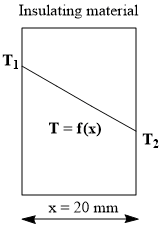
A non-deforming, extrude insulating material’s heat transmission coefficient is given as 0,029 W/m-K. 100C temperature difference is measured through 20mm thick insulating material. What is the heat flux transmitting inside 2mx2m sized insulating material? What is the velocity of heat transmission? Please instil the knowns and unknowns by delienating the sequence. Please write your all assumptions in detailed.
Consider the insulating material as shown in figure below:

The following assumptions are made for the heat transfer though the insulating material
1) Steady-state conduction: Here the temperature is the function of x. While the Area A, is not a function of direction i.e. x, and thermal conductivity k is not a function of temperature T.
2) Fourier's law of conduction is applicable for this condition
qA= (equation 1)
Where, q/A = Heat flux (W/m2)
Integrating the above equation yields a straight line equation. That is why, in the above figure, the temperature profile is a straight line with negative slope. If k becomes a function of temperature, the temperature profile would change.
Given: k = 0.029 W/m.k
x = thickness = 20 mm = 0.02 m
Required: (q/A) =?
From equation 1;
Heat flux = (Answer a)
Step by stepSolved in 3 steps with 1 images

- Heat transferarrow_forward10. For plate heat exchanger, turbulent flow A) can not be achieved under low Reynolds number B) only can be achieved under high Reynolds number C) can be achieved under low Reynolds number D) can not be achieved under high Reynolds numberarrow_forwardPlease solve the question quicklyarrow_forward
 Introduction to Chemical Engineering Thermodynami...Chemical EngineeringISBN:9781259696527Author:J.M. Smith Termodinamica en ingenieria quimica, Hendrick C Van Ness, Michael Abbott, Mark SwihartPublisher:McGraw-Hill Education
Introduction to Chemical Engineering Thermodynami...Chemical EngineeringISBN:9781259696527Author:J.M. Smith Termodinamica en ingenieria quimica, Hendrick C Van Ness, Michael Abbott, Mark SwihartPublisher:McGraw-Hill Education Elementary Principles of Chemical Processes, Bind...Chemical EngineeringISBN:9781118431221Author:Richard M. Felder, Ronald W. Rousseau, Lisa G. BullardPublisher:WILEY
Elementary Principles of Chemical Processes, Bind...Chemical EngineeringISBN:9781118431221Author:Richard M. Felder, Ronald W. Rousseau, Lisa G. BullardPublisher:WILEY Elements of Chemical Reaction Engineering (5th Ed...Chemical EngineeringISBN:9780133887518Author:H. Scott FoglerPublisher:Prentice Hall
Elements of Chemical Reaction Engineering (5th Ed...Chemical EngineeringISBN:9780133887518Author:H. Scott FoglerPublisher:Prentice Hall
 Industrial Plastics: Theory and ApplicationsChemical EngineeringISBN:9781285061238Author:Lokensgard, ErikPublisher:Delmar Cengage Learning
Industrial Plastics: Theory and ApplicationsChemical EngineeringISBN:9781285061238Author:Lokensgard, ErikPublisher:Delmar Cengage Learning Unit Operations of Chemical EngineeringChemical EngineeringISBN:9780072848236Author:Warren McCabe, Julian C. Smith, Peter HarriottPublisher:McGraw-Hill Companies, The
Unit Operations of Chemical EngineeringChemical EngineeringISBN:9780072848236Author:Warren McCabe, Julian C. Smith, Peter HarriottPublisher:McGraw-Hill Companies, The





